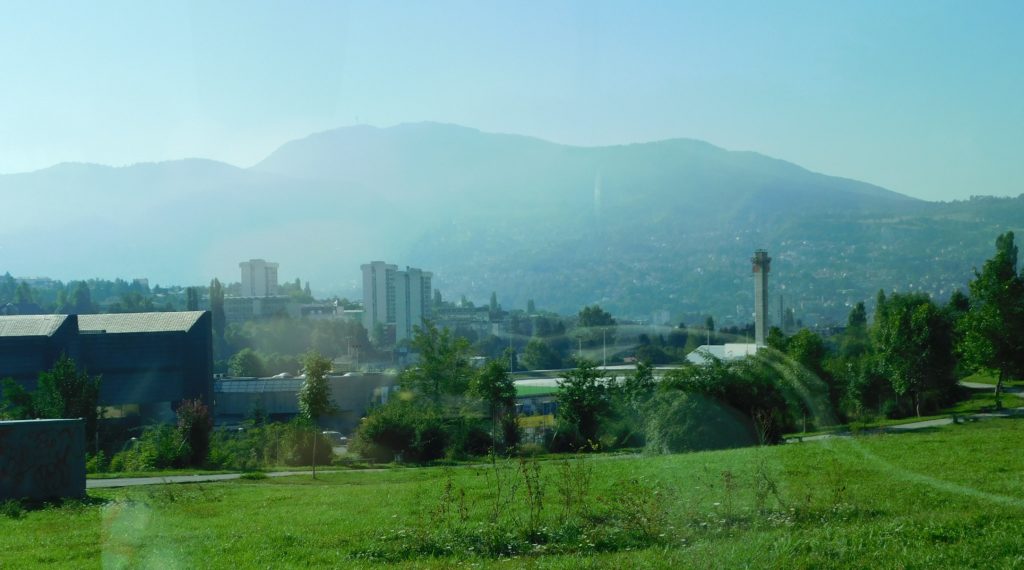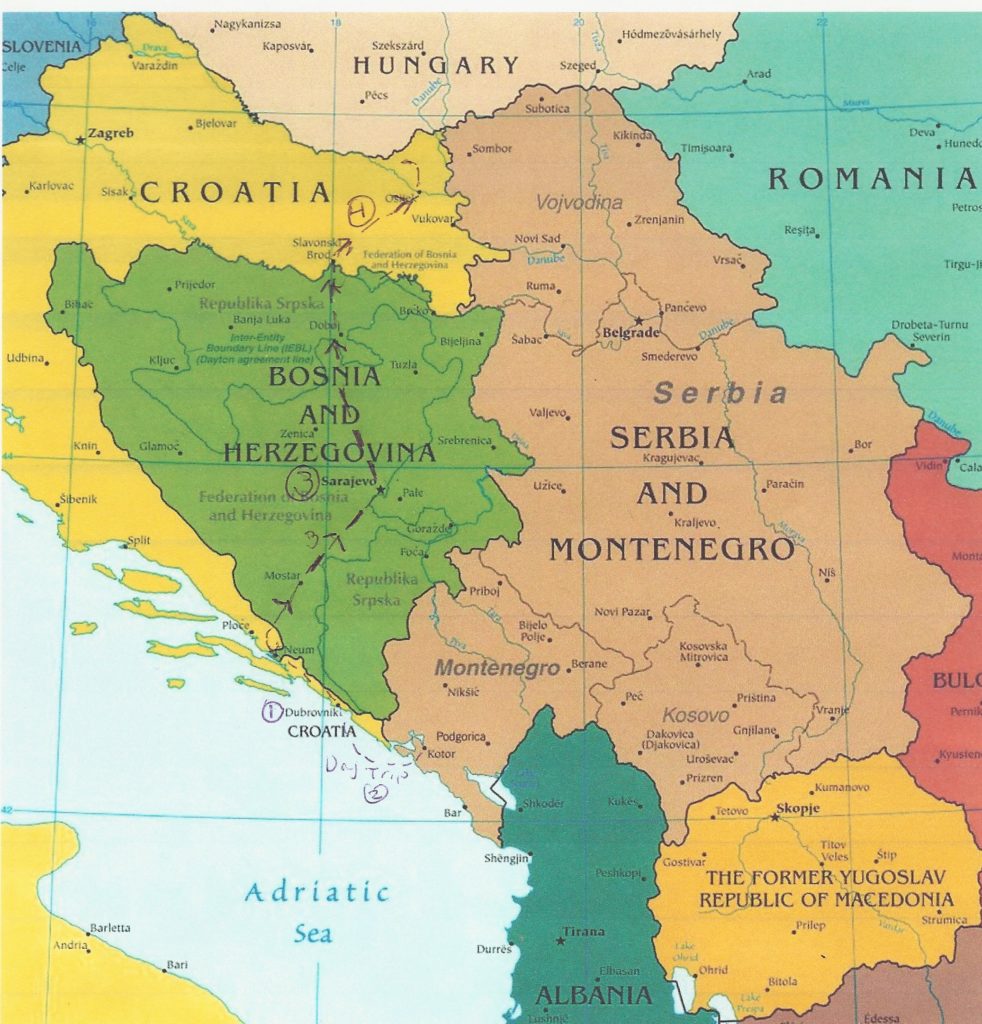But first a few final words as we leave Sarajevo.
On my trip last year, I touched down in four different Olympic Games host cities – two that had hosted the Summer Games – Stockholm (1912) and Helsinki (1952) – and two Winter Games hosts – Oslo (1952) and Lillehammer (1994). As sports fans might remember without prompting or as readers might remember from my first entry about Sarajevo, this small city hosted the XIV Olympic Winter Games in 1984 when it was part of the former Yugoslavia. As we drove out of the city, we passed a clear reminder of that. (In 2021 and 2022, I created a series of posts touching upon all the Olympic Games host cities I’d visited to that time.)
 Â The tower on the right is the cauldron of the Olympic Flame. More than 30 years later, those Sarajevans old enough to remember hosting the Games do so with a sense of awe and pride.
 The tower on the right is the cauldron of the Olympic Flame. More than 30 years later, those Sarajevans old enough to remember hosting the Games do so with a sense of awe and pride.
The Games, the first Winter Games to be held in a communist country, were scheduled to run from the eighth to the nineteenth of February 1984. In a typical winter, upwards of 150 millimeters of snow would have already fallen in Sarajevo and on the surrounding mountains – Jahorina, Bjelašnica, Igman, and Trebević – that would serve as venues for the event. But 1984 was no ordinary winter. In fact, up to and including the early evening hours of 7 February not a snowflake was in sight.
The world, in the form of athletes and spectators, had come to Sarajevo for the Winter Games and, the night before the opening ceremony, all they could do was dance and party in the Baščaršija in spring like weather. There was no snow. Then the Sarajevo Miracle occurred. Thirty years later Azra Nuhefendić wrote this:
In such an atmosphere it began to snow. I still remember exactly where I was: on Vase Miskina, today Ferhadija street, where the old part of the city, the Baščaršija, begins. There were people jumping with joy. Others held hands and danced, someone screamed. I was laughing uncontrollably, holding my arms open, turning around with my head up. I wanted to feel the snowflakes on my face.
I believe that on that evening many Communist leaders, necessarily atheists, thanked God.
It kept snowing in earnest, all night. The snow was beautiful, dry, the kind that does not dissolve immediately, but stays. The snowflakes were big, stylish as butterflies. At first the snow was falling shyly, then more and more dense. It seemed that someone up there had opened up a bag, and was no longer able to control the speed at which it emptied.
Before, we had been worried because there was no snow. Now, the situation had reversed. In a few hours there was more than a metre of snow.
If you’re interested, you can read the rest of his tale of wonder here.
In another reflection on those games, this video that aired during NBC’s coverage of the 2002 Winter Olympics paints a picture of the tolerant city that existed before the war that aligned well with the descriptions we’d heard from native Sarajevans but it also looks at the harder truth of its post-war experience:.
For those readers who chose not to watch the video, it notes that the city put in a bid to host the 2010 Winter Games. We know that Sarajevo failed in that bid. Today, most of the venues that survived the war have been abandoned. It is, perhaps, with some sense of irony that one of those, the bobsled track, has become something of an offbeat tourist destination. There are 18 Google reviews of the site and The Exploring Kiwis, a New Zealand couple living in Abu Dhabi, snapped this photo just a few days after our group had left.
If you’re interested in other pictures of the track and other venues, Buzzfeed ran this pictorial essay on the 30th anniversary.
On the return trip to Croatia.
Today we depart Bosnia and Herzegovina to return to Croatia for nearly a week. We’ll spend our first night in the village of Karanac which is in the region of Slavonia. Please don’t confuse it with Slovenia – which we will visit next week. Slavonia is a region in Croatia. It is not the former Yugoslav republic and now independent country of Slovenia. Perhaps the map below will help but with a few words of caution.
This isn’t a current map of the region. It’s a political map from 2003 that I chose because it was the best one I could find to provide the proper orientation. (Recall that Serbia and Montenegro formed a single political entity for a time after the other former Yugoslav republics declared their independence.) You can see Slovenia in the upper left of the map though you can’t see the parts of Croatia that stretch farther to the west.
I’ve tried to trace our route to date. If you locate the word Croatia in the Adriatic, you’ll see our starting point, Dubrovnik just above it (marked with a circled 1). The circled 2 shows our day trip to Montenegro. Â You can then follow us up the coast to Neum, Mostar, and on to Sarajevo marked with a three. Today we will proceed north northeast passing from the Federation of B&H through the Republika Srpska and cross the border back into Croatia at the town of Slavonski Brod.
You can see that Croatia is roughly shaped like a boomerang with the sort of triangular B&H nestled in the crook. The circled 4 is between the cities of Slavonski Brod and Osijek (which is a bit obscured by my drawn arrow). Although not precise, you can think of everything to the east of the longitude marker that passes through Slavonski Brod as the region of Slavonia. Alternatively, if you look at a more detailed map, you can find the southern, eastern, and northern borders of the region by finding the rivers Sava, Danube (forms the border with Serbia), and Drava (forms a border with Hungary).
Karanac is about 30 kilometers north of Osijek. Sporting a population a bit north of 105,000, the latter is the fourth largest city in Croatia while the former is a village of fewer than 1,000 inhabitants. They both lie in a curious area called Baranja that, because of ties to Hungary and some of the treaties that defined the territory, gave part of the region to Hungary and part to Croatia. The upshot is that many consider Barajna both a part of and distinct from Slavonia. But this is the Balkans so why should we expect anything else?
Note: In keeping with my 2022-2023 reformation of the blog into shorter entries, backdated to maintain their sequence, any comments on this post might pertain to its new configuration. See the full explanation in the post Conventions and Conversions.


you’re doing a great job describing our trip.
As I told Alison, I appreciate the feedback.
I loved the courtyard effect of the place you stayed. And your hostess Lilly is a marvel. I wish you had images of her jewelry.
I certainly agree that Lilly struck me as a marvel.